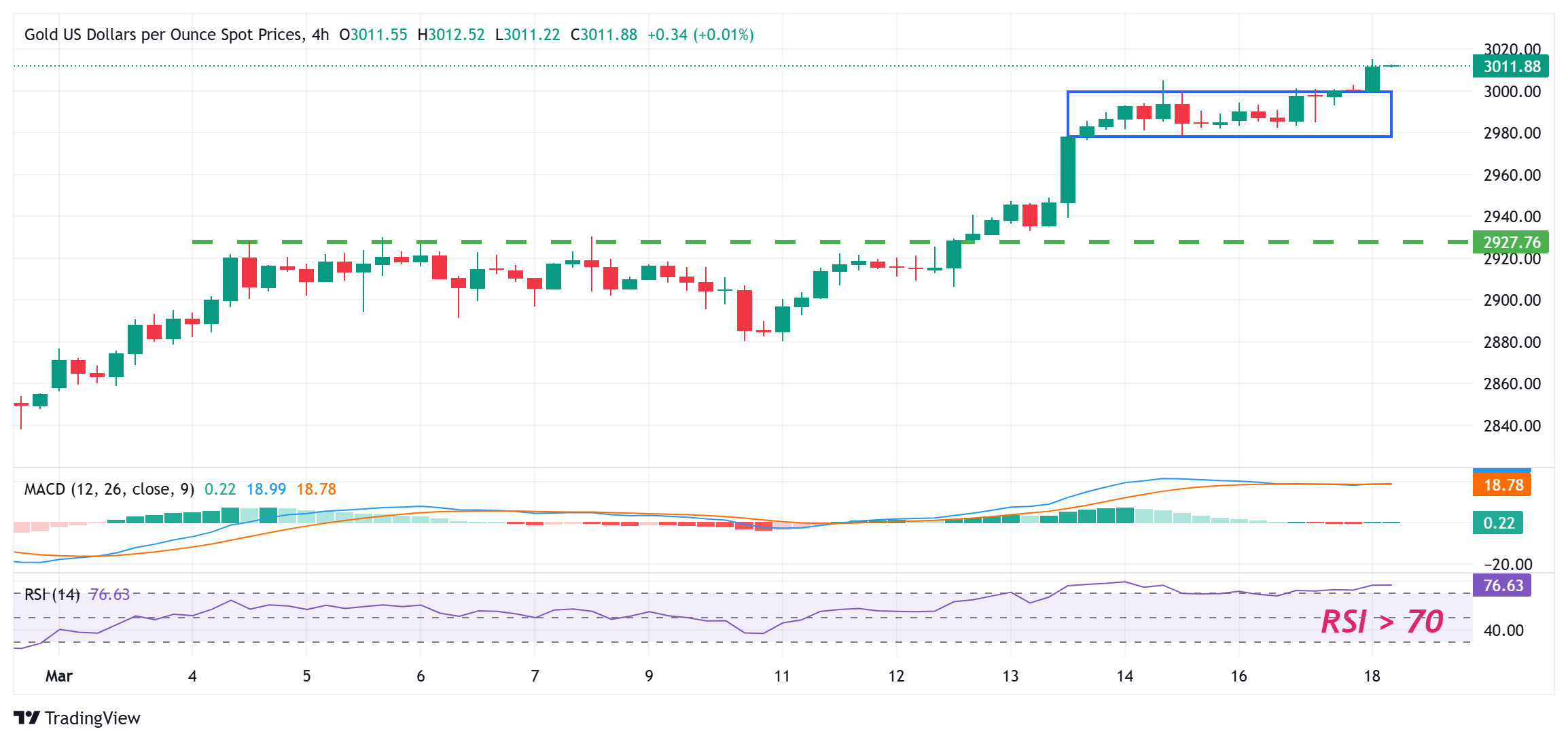Gold prices continue to attract safe-haven inflows amid trade tensions and geopolitical risks.
Markets are betting on multiple rate cuts from the Federal Reserve this year, further supporting gold.
A modest rebound in the U.S. dollar and risk-on sentiment could limit upside in XAU/USD.
Gold prices (XAU/USD) rose for a second day in a row - and the fifth day of positive movement in the past six days - hitting a new high of around $3,010 during the Asian session on Tuesday. The risk of further escalation of tensions in the Middle East amid uncertainty over U.S. President Donald Trump's trade tariffs and U.S. recession fears drove safe-haven demand and provided a boost to gold. Also, less-than-stellar consumer spending data released on Monday further bolstered market expectations for more rate cuts from the Federal Reserve (Fed), supporting the non-yielding yellow metal.
However, investors still need to watch whether the bull market can maintain its dominance on the back of risk-on sentiment, which is supported by optimism about China's stimulus measures and may weaken demand for gold prices. Meanwhile, the US dollar (USD) slightly recovered from five-month lows on some repositioning trades ahead of the start of the Federal Reserve's two-day monetary policy meeting. This may further limit the upside of the commodity. Traders may choose to wait for further market moves before the highly anticipated decision of the Federal Reserve on Wednesday.
The Israeli Defense Forces (IDF) said it is conducting "extensive strikes" in the Gaza Strip and targeting what it calls Hamas "terrorist targets". Negotiations on extending the ceasefire in Gaza at a meeting in Qatar failed to reach an agreement, increasing the risk of further escalation of geopolitical tensions in the region.
U.S. Treasury Secretary Scott Bessent said on Sunday that there was no guarantee that the U.S. economy would avoid a recession this year, and concerns about an economic slowdown resurfaced. This further supported demand for traditional safe-haven assets and pushed gold prices to a new all-time high in Asian trading on Tuesday.
On the economic data front, the U.S. Census Bureau reported on Monday that U.S. retail sales rose 0.2% in February, compared with a revised decline of 1.2% in the previous month. The data was lower than the market's expectations of a 0.7% increase, showing cautious consumer sentiment and boosting market bets that the Federal Reserve will resume its rate-cutting cycle.
Fed fund futures show that the U.S. central bank may reduce its monetary policy by 25 basis points each at its monetary policy meetings in June, July and October. This could limit the dollar's rebound from its lowest level since October 2024 hit on Monday and provide further support to the non-yielding yellow metal.
Meanwhile, US President Donald Trump expressed optimism that Russia and Ukraine can reach a ceasefire and eventually a peace deal. This comes ahead of Trump's peace talks with Putin on Tuesday, which, along with optimism over Chinese stimulus announced over the weekend, continue to support market optimism.
Traders are now focused on Tuesday's US economic calendar - including the release of building permits, housing starts and industrial production data. However, the focus will remain on the outcome of Wednesday's two-day Federal Reserve meeting, which will drive near-term demand for the US dollar and provide new directional momentum for the gold/dollar pair.

From a technical perspective, acceptance above the psychological $3,000 mark is seen as a new trigger for bullish traders. Nonetheless, the RSI on the daily chart has started to show slightly overbought conditions. This makes it wise to wait for some short-term consolidation or a modest pullback before continuing the nice uptrend of the last three months or so.
Meanwhile, any pullback below the immediate support of $2,980-2,978 could be seen as a buying opportunity with limited resistance around $2,956. However, a sustained break below the latter could trigger some technical selling and drag gold prices to the $2,930-2,928 level, and in turn towards the $2,900 round-number mark and last week's low of around $2,880.
Gold has played a key role in human history as it is widely used as a store of value and a medium of exchange. Currently, in addition to its lustre and use in jewellery, gold is widely viewed as a safe haven asset, meaning it is considered a good investment in turbulent times. Gold is also widely viewed as a hedge against inflation and currency debasement as it is not dependent on any particular issuer or government.
Central banks are the largest holders of gold. To support their currencies during turbulent times, central banks tend to diversify their reserves and buy gold to boost the perception of economic and monetary strength. High gold reserves can be a source of confidence in a country's solvency. According to the World Gold Council, central banks added 1,136 tons of gold reserves in 2022, worth about $70 billion. This is the highest annual purchase on record. Central banks in emerging economies such as China, India and Turkey are rapidly increasing their gold reserves.
Gold is negatively correlated with the U.S. dollar and U.S. Treasuries, both of which are major reserve assets and safe havens. Gold tends to rise when the dollar depreciates, allowing investors and central banks to diversify their assets during turbulent times. Gold is also negatively correlated with risky assets. Stock market rebounds tend to push gold prices lower, while sell-offs in riskier markets tend to benefit gold.
Prices can move due to a wide variety of factors. Geopolitical instability or concerns about a deep recession can quickly push up gold prices due to its safe-haven status. As a low-yielding asset, gold tends to rise as interest rates fall, while higher funding costs usually weigh on gold. Still, since the asset is priced in U.S. dollars (XAU/USD), most moves depend on the performance of the U.S. dollar (USD). A strong dollar tends to control gold prices, while a weak dollar can push gold prices higher.